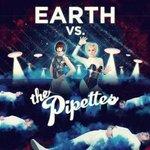
The Pipettes Earth vs. the Pipettes
(Fortuna Pop!)
Lineup changes are never an easy thing. Whether band members have irreconcilable differences due to a conflicting artistic vision, or can simply no longer put up with each other’s demands, the ones who suffer through all this strife are the listeners. Considered as “manufactured pop” from the get-go, it shouldn’t really matter if The Pipettes brand name changes from time to time. The gimmick was established even before the former Brighton beauties made the stage for the first time: a producer with a vision recruits some talented performers, further delimits the popular motif in hand, and sculpts it until every detail is perfected.
Fifty years later, this overly systematic approach into creating popular music remains just as prevalent. The unfortunate side to the Pipettes’ rebirth is that the former formula was simply too charming to ignore. Could anyone forget the polka dots and posh looks, the Warholian promotional spots and caricaturesque winks, or the cleverly sexualized lyrical nuances? Even before the current Spectorian revival, the trio remained classy but also thoroughly conscious about independent musical trends. There was a DIY aesthetic to the sound: sure, the faultless harmonies were the main attraction, but the jangly chords and scruffy, garage-tuned drum fills gave it a welcome contemporary slant to both old and new spectators. Beneath the choreographed dances and neon signs, the trio exemplified a down to earth impression of themselves towards those who admired them.
Judging from their new image, the Pipettes are no longer sewing from the same thread. Instead of teasing mod wannabes with their playful kisses and pursed lips, they’re upfront flirts zapping comb-overs with leather outfits. What’s most disappointing is that the Pipettes trademark must remain, even if it completely demolishes a truer, more warmhearted approach. They’re still intent on recreating past sounds; instead of modernizing a common tale, they now cling to nostalgia for nostalgia’s sake. But let bygones be bygones. Concentrating on 2010’s Pipettes, the completely reformatted duo shows a flair for disco-tinged guitars, dance anthems, and right out-of-the-box synthesized programming. Trying to lazily mimic ABBA’s seminal Arrival, glissando keyboards and shimmering strings frolic over some quaint dance-pop that refuses to perish.
For Earth vs. the Pipettes to exist in the pop gamut, its unforgivable how it seamlessly passes from one track to the next without a memorable chorus or a distinctive hook. After shaking up pretty much everything that made the original Pipettes such a surprise at the time, they have kept the doowop harmonies when it really doesn’t hold up with the uncontrolled mix. Sisters Gwenno and Ani Saunders don’t have the same vocal range as the original trio - they sound more like backup vocalists than main vocal performers. They mostly go through the motions, shunning the former ironic remarks and female empowerment exclamations to come out as languishing girls desperately seeking for attention.
The real fault isn’t in how the Pipettes diversify their template, but how they only take the superficial aspects of disco pop to engrave them with walloping production values. The gimmick is never the real issue: for example, Our Love was Saved by Spaceman actually hits the right notes by going full on roller disco with its gyrating keyboards and Kylie Minogue-like vocals. The rest is mostly embarrassing techno samples, processed vocal experiments, and laughable Funkadelic guitar chords. It's not too hard to imagine the Saunders sisters staring aimlessly while some confused producers shuffle the cards until randomly finding their rhythmic groove. And that’s the worst thing about this record: constantly thinking of the word studio when you’re trying to invest some emotion.
21 November, 2010 - 15:25 — Juan Edgardo Rodriguez